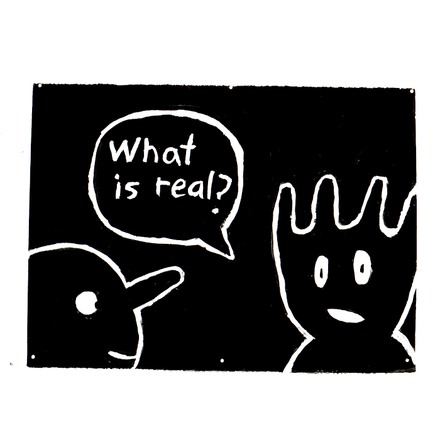I-DOCS: Who are you, where did you come from and what will you become?
A definition of i-docs comes from the reading Interactive documentary: setting the field by Judith Aston and Sandra Gaudenzi: any project that starts with an intention to document the ‘real’ and that uses digital interactive technology to realize this intention.
I agree that the definition should be purposely left broad, however I’m interested in the fact that authors have put ‘real’ in quotation marks. This begs the question of what is ‘real‘, a whole other philosophical discussion.

“Interactivity is seen as a means through which the viewer is positioned within the artefact itself, to play an active role in the negotiation of the ‘reality’ being conveyed through the i-doc… it involves going beyond the act of interpretation to create feedback loops with the digital system itself.”
The article mentions that “different understandings of interactivity have led to different types of digital artefacts“. The importance of different perceptions and perspectives I’ve never really seen discussed, but it is essential as it comprises our eccentric and endless world-view.
Guadenzi proposes four interactive modes: the conversational, the hypertext, the experiential and the participative.
The conversational mode “positions the use as if ‘in conversation’ with the computer“, eg ‘factual games’ or ‘docu-games’.
The Hypertext mode “links assets within a closed video archive and gives the user an exploratory role, normally enacted by clicking on pre-existing options.”
The Participatory mode “counts on the participation of the user to create an open and evolving database“.
The Experiential mode “brings users into physical space, and creates an experience that challenges their senses and their enacted perception of the world“.
Aston proposes that “the most interesting work in i-docs often arises when genre is transcended and boundaries are blurred“, which based on my previously mentioned obsession with contrast and conflict I agree with this statement wholeheartedly for any creative work.
The 90-9-1 principle is mentioned in the reading, which suggests “there is a participation inequality on the Internet with only 1% of people creating content, 9% editing or modifying that content, and 90% viewing content without actively contributing“. The simplest way I imagine this rule is through YouTube, with 1 per cent of people making videos, 9 per cent of viewers commenting on videos, and 90 per cent watching without interacting at all. Because of this rule, whenever I see a YouTube video with 10 per cent or more of views translated into ‘likes’, it is pretty clear to me that the audience of this video has enjoyed the content.

Reading all these facets regarding i-docs from the symposium I do find myself wondering if this need and want for interactivity is misguided. I’ve never once felt inclined to comment on a YouTube video, tweet a TV show or send a photo to a news broadcaster, and I think the 90-9-1 principle is valid for a reason. When I turn on a Louis Theroux doco, I lean back and watch what has been neatly packaged for me, no input necessary. I think the creation of these different modes is endlessly inspiring for creativity, but I do wonder at the success of these projects in a world where only 9 per cent of us contribute.
In the reading The field of digital documentary: a challenge to documentary theorists by Craig Hight, ‘digital documentary’ is suggested as offering “the potential to change the nature of documentary practices, aesthetics, forms of political engagement and the wider relationship of documentary culture as a whole to the social-historical world.”
Hight permits that the “digital transformation suggests a radical shift in the basis of documentary culture“, with remediation and the appropriation of cultural forms coming into play. Studying Studio Art in high school I was very interested in this idea of re-appropriation, with themes of conflict and contrast being explored, as well as the spaces between all things and what they mean. The following video Simmons & Burke (Repute Re-Appropriation) from Gabriel Sunday on Vimeo demonstrates this reappropriation in art in the form of a mini documentary, so I think it’s… appropriate.
Hight asks the question: “what effect on film-making practice will follow from the inclusion within iMovie of a preset selection for something that is labelled the ‘Ken Burns effect’, which mimics that director’s trademark panning of photographic material as a central device for the construction of historical narrative?” Similarly, why couldn’t someone create a Wes Anderson or Quentin Tarantino effect in order to create new possibilities such as trailer re-imaginings, and why shouldn’t they? I think it’s imperative for new media to maintain a sense of playfulness, and these options may spawn a million mediocre mashups, but they also provide new avenues to creativity.
“The possibilities that derive from the ability of desktop computer software to merge existing traditions of photography, information design, and the varieties of moving image production into an expanded palette for motion graphics. The result is a distinctive ‘hybrid, intricate, complex and rich visual language’, one that is becoming more and more accessible to amateur media producers.”
DVD has allowed for the rise of specialist distributors, while online distribution has created opportunities for distribution of independent documentary productions, not to mention the proliferation of user-created material such as YouTube. “This kind of online environment provides for bother the flowering of the work of new documentary auteurs, and also their swamping within an ocean of more mediocre offerings.” This makes me question how we find the good things: do we depend on others to share things with us, whether that is our friends on their Facebook walls, advertisements or suggestions from YouTube based on other videos we’ve watched?
Hight also brings up computer games in talking about new digital forms of media, which I previously haven’t considered as a type of documentary, but based on the number of games revolving around real historical events, it does open doors for what interactive documentary is and could be.